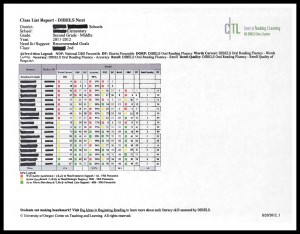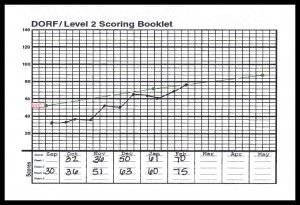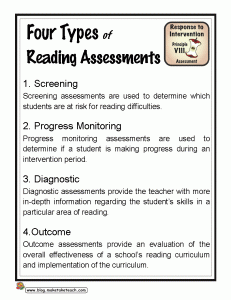Assessment and intervention is the heart and soul of Response to Intervention (RtI). Prior to beginning either a school-wide program or developing an intervention plan for a particular student, it is critically important to have assessment data. There are 4 types of reading assessments that comprise a comprehensive K-3 reading assessment plan. Each type of assessment is important in its own right and provides valuable information to school teams in the RtI process. So, take a look at these types of assessments. How comprehensive is your K-3 reading assessment plan?
1. Screening- The purpose of a screening assessment is to identify students who are at-risk for reading difficulties. Identifying the students early on who are likely to struggle with learning to read is important as we can then develop intervention plans that, hopefully, PREVENT a life-long reading deficit.
The DIBELS Next and the Aimsweb assessments are the two most commonly administered screening assessments in schools. Our schools utilize the DIBELS Next assessments. Students are screened three times a year using the particular assessments designed for each grade level. For example, students in 2nd-6th grade read 3 grade level passages for one minute. The number of words correct per minute (wcpm) is calculated and compared to an expected level of performance. The assessments are easy to administer and take no more than 8 minutes per student. When the data is entered into the computer-based system, a variety of charts/graphs are provided for school-based problem solving teams to analyze. Below is a sample of a class list report that a teacher will receive after each benchmark period.
2. Progress Monitoring- The purpose of progress monitoring is to track student performance during an instructional period. Once a student is identified as at-risk for reading difficulties, an intervention plan is developed. Every week or every other week, the student is assessed with a progress monitoring probe (usually a one minute assessment). The purpose of the assessment is to determine if the student is making progress when provided with the additional support. Below is a sample of a progress monitoring chart measuring oral reading fluency for a 2nd grade student.
Both DIBELS Next and Aimsweb offer progress monitoring assessments.
3. Diagnostic- Diagnostic assessments provide the teacher with more in-depth information about the student’s skills. Diagnostic assessments can range from standardized assessments to teacher-made classroom assessments. The Quick Phonics Screener and the Primary Spelling Inventory are two assessments that we use to help us target specific deficits in the area of phonics. We also find that having a running records assessment is helpful when designing interventions. Several schools use the Rigby Running Records while others use the Diagnostic Reading Assessment. In Michigan, we use the Michigan Literacy Progress Profile to assess letters/sounds and specific phonemic awareness skills.
4. Outcomes- Outcome assessments are typically administered once a year. These assessments are usually referred to as “high stakes” assessments and the data is used to assess curriculum design, implementation and teachers’ efforts over the course of a school year. Outcome assessments provide standard scores and percentiles so that the problem solving team (and parents) can compare a particular student’s performance to peers across the nation as well as peers within the district. The two outcome assessments used in my schools are the Gates-MacGinitie for kindergarten and the Iowa Test of Basic Skills. Although these assessments provide valuable information, they are costly and time consuming to administer.
Click the following link to download this poster 4 Types of Reading Assessments
Be sure to check back as I will be exploring each type of assessment in future blog postings. This post corresponds with Priniciple 8 of the 8 Core Principles of Response to Intervention.






Leave a Reply